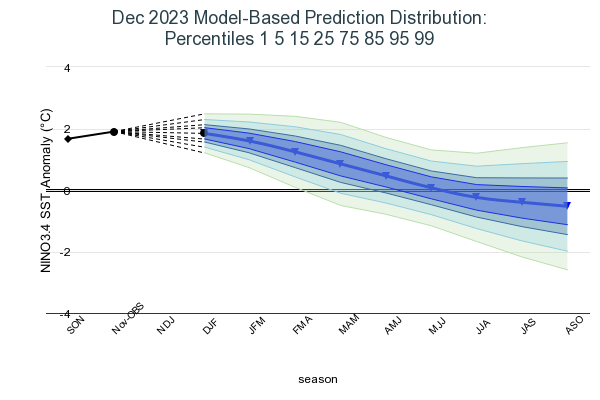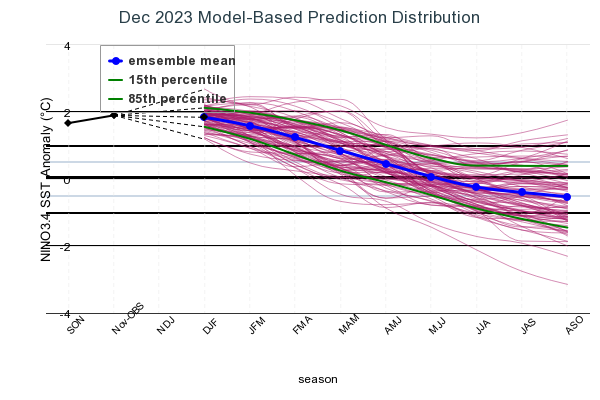IRI ENSO Forecast
IRI Technical ENSO Update and Model-Based Probabilistic ENSO Forecast
Published: December 19, 2023
Note: The SST anomalies cited below refer to the OISSTv2 SST data set, and not ERSSTv5. OISSTv2 is often used for real-time analysis and model initialization, while ERSSTv5 is used for retrospective official ENSO diagnosis because it is more homogeneous over time, allowing for more accurate comparisons among ENSO events that are years apart. These two products may differ, particularly during ENSO events. The difference between the two datasets may be as much as 0.5 °C. Additionally in some years, the ERSSTv5 may tend to be cooler than OISSTv2 in the context of warming trends, because ERSSTv5 is expressed relative to a base period that is updated every 5 years, while the base period of OISSTv2 is updated every 10 years. In February 2021, both datasets were updated to reflect the 1991-2020 climatology period.
Recent and Current Conditions
The SST anomaly for NINO3.4 during the Sep-Nov 2023 season was +1.67 °C, and for the month of Nov 2023 it was +1.90 °C. The most recent weekly (13 Dec 2023) anomaly in the NINO3.4 region was +2.0 °C, indicating that the tropical Pacific is still experiencing strong El Niño conditions. An occurrence is deemed a “historically strong” El Niño when the temperature in the Niño-3.4 region equals or surpasses 2.0°C. The IRI’s definition of El Niño, like NOAA/Climate Prediction Center’s, requires that the monthly SST anomaly in the NINO3.4 region (5S-5N; 170W-120W) exceed 0.5 °C. Similarly, for La Niña, the anomaly must be -0.5 °C or colder
The tropical Pacific oceanic and atmospheric anomalies are consistent with an ongoing El Niño event, though the atmospheric variables are quite weak as compared to past El Niño events of similar magnitude. The traditional Southern Oscillation Index currently falls within the El Niño range (as of November 2023, the last recorded value was -8.6). Simultaneously, the equatorial Southern Oscillation Index registers a value of -1.3 for the same month. Although both indices are indicative of El Niño conditions, neither value is characteristic of a strong event. Indonesia was characterized by positive anomalies in Outgoing Longwave Radiation (OLR), indicating suppressed convection and reduced precipitation. Conversely, negative OLR anomalies, denoting enhanced convection and increased precipitation, were observed near the Date Line, extending into the eastern Pacific just north of the equator. Westerly anomalies in low-level (850-hPa) winds were evident over the eastern half of the equatorial Pacific, while easterly anomalies characterized upper-level (200-hPa) winds along the equatorial Pacific. Throughout the equatorial Pacific Ocean, there is a widespread presence of positive subsurface temperature anomalies, covering a substantial portion of the central to eastern Pacific region (170E to 80W). Concurrently, negative subsurface temperature anomalies in the western Pacific Ocean have intensified and expanded westward to 150ºW, persisting at depths below 100 meters. Together, the coupled ocean-atmosphere system reflected an ongoing El Niño conditions.
Expected Conditions
Note – Only models that produce a new ENSO prediction every month are considered in this statement.
What is the outlook for the ENSO status going forward?
The El Niño/Southern Oscillation (ENSO) Diagnostic Discussion released on on 14 Dec 2023 by the Climate Prediction Center/NCEP/NWS continued the El Niño advisory.
The latest set of ENSO prediction models from mid-December 2023 are now available in the IRI ENSO prediction plume. These are used to assess the probabilities of the three ENSO categories by using the average value of the NINO3.4 SST anomaly predictions from all models in the plume, equally weighted. A standard Gaussian error is imposed over that averaged forecast, with its width determined by an estimate of overall expected model skill for the season of the year and the lead time. Higher skill results in a relatively narrower error distribution, while low skill results in an error distribution with width approaching that of the historical observed distribution.
The IRI ENSO prediction plume indicates a very high likelihood of El Niño conditions persisting during the first quarter of 2024. Specifically, during the winter and spring of 2024, the probabilities of El Niño range from 100% to 84% (Jan-Mar: 100%, Feb-Apr: 98%, and Mar-May: 84%). Thereafter, there is a rapid decrease in the probability of El Niño and a transition to ENSO-neutral is likely in Apr-Jun 2024 (53% chance for ENSO-neutral). The ENSO-neutral category remains most likely during May-Jul: (67%), Jun-Aug (54%). In Jul-Sep, the chances of La Nina and ENSO-neutral are comparable (about 46%). In Aug-Oct, 2024, La Niña becomes the most likely category (52% chance). A plot of the probabilities summarizes the forecast evolution.The climatological probabilities for La Niña, ENSO-neutral, and El Niño conditions vary seasonally, and are shown by the lines on the plot, and are given in a table at the bottom of this page for each 3-month season.
Caution is advised in interpreting the forecast distribution from the Gaussian standard error as the actual probabilities, due to differing biases and performance of the different models. In particular, this approach considers only the mean of the predictions, and not the total range across the models, nor the ensemble range within individual models. At longer leads, the skill of the models degrades, and uncertainty in skill must be convolved with the uncertainties from initial conditions and differing model physics, which leads to more climatological probabilities in the long-lead ENSO Outlook than might be suggested by the suite of models. Furthermore, the expected skill of one model versus another has not been established using uniform validation procedures, which may cause a difference in the true probability distribution.
In summary, the forecast for the first quarter of 2024 shows a very high probability of continued El Niño conditions. The chances of a return to ENSO-neutral conditions then rapidly increases to about 53% in Apr-Jun, 2024 and becomes the most probable category thereafter for next two or three seasons. La Niña becomes the most likely category in Aug-Oct 2024, with moderate confidence (52%).
A caution regarding the model-based ENSO plume predictions released mid-month, is that factors such as known specific model biases and recent changes in the tropical Pacific that the models may have missed, are not considered. This approach is purely objective. Those issues are taken into account in the official outlooks, which are generated and issued early in the month by CPC, and which will include some human judgment in combination with the model guidance.

| Season |
La Niña |
Neutral |
El Niño |
| DJF |
0 |
0 |
100 |
| JFM |
0 |
0 |
100 |
| FMA |
0 |
2 |
98 |
| MAM |
0 |
16 |
84 |
| AMJ |
1 |
53 |
46 |
| MJJ |
13 |
67 |
20 |
| JJA |
34 |
54 |
12 |
| JAS |
44 |
46 |
10 |
| ASO |
52 |
38 |
10 |





